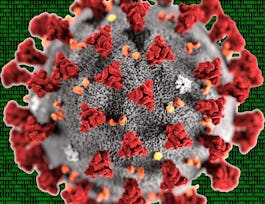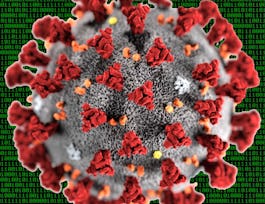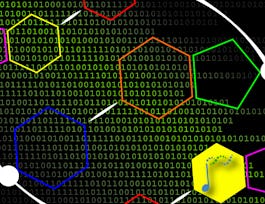In previous courses in the Specialization, we have discussed how to sequence and compare genomes. This course will cover advanced topics in finding mutations lurking within DNA and proteins.



Finding Mutations in DNA and Proteins (Bioinformatics VI)
This course is part of Bioinformatics Specialization


Instructors: Pavel Pevzner
Sponsored by Coursera for Reliance Family
16,102 already enrolled
(60 reviews)
Skills you'll gain
Details to know

Add to your LinkedIn profile
3 assignments
See how employees at top companies are mastering in-demand skills

Build your subject-matter expertise
- Learn new concepts from industry experts
- Gain a foundational understanding of a subject or tool
- Develop job-relevant skills with hands-on projects
- Earn a shareable career certificate


Earn a career certificate
Add this credential to your LinkedIn profile, resume, or CV
Share it on social media and in your performance review

There are 6 modules in this course
<p>Welcome to our class! We are glad that you decided to join us.</p><p>In this class, we will consider the following two central biological questions (the computational approaches needed to solve them are shown in parentheses):</p><ol><li>How Do We Locate Disease-Causing Mutations? (<em>Combinatorial Pattern Matching</em>)</li><li>Why Have Biologists Still Not Developed an HIV Vaccine? (<em>Hidden Markov Models</em>)</li></ol><p>As in previous courses, each of these two chapters is accompanied by a Bioinformatics Cartoon created by talented artist Randall Christopher and serving as a chapter header in the Specialization's bestselling <a href="http://bioinformaticsalgorithms.com" target="_blank">print companion</a>. You can find the first chapter's cartoon at the bottom of this message. </p><p><img src="https://stepic.org/media/attachments/lessons/292/chapter7_cropped.jpg" title="Image: https://stepic.org/media/attachments/lessons/292/chapter7_cropped.jpg" width="528"></p>
What's included
4 videos2 readings1 assignment2 app items
<p>Welcome to week 2 of the class!</p> <p>This week, we will introduce a paradigm called the Burrows-Wheeler transform; after seeing how it can be used in string compression, we will demonstrate that it is also the foundation of modern read-mapping algorithms.</p>
What's included
3 videos1 reading2 app items
<p>Welcome to week 3 of class!</p> <p>Last week, we saw how the Burrows-Wheeler transform could be applied to multiple pattern matching. This week, we will speed up our algorithm and generalize it to the case that patterns have errors, which models the biological problem of mapping reads with errors to a reference genome.</p>
What's included
4 videos1 reading1 assignment2 app items
<p>Welcome to week 4 of class!</p> <p>This week, we will start examining the case of aligning sequences with many mutations -- such as related genes from different HIV strains -- and see that our problem formulation for sequence alignment is not adequate for highly diverged sequences.</p> <p>To improve our algorithms, we will introduce a machine-learning paradigm called a hidden Markov model and see how dynamic programming helps us answer questions about these models.</p>
What's included
5 videos2 app items
<p>Welcome to week 5 of class!</p> <p>Last week, we introduced hidden Markov models. This week, we will see how hidden Markov models can be applied to sequence alignment with a profile HMM. We will then consider some advanced topics in this area, which are related to advanced methods that we considered in a previous course for clustering.</p>
What's included
5 videos1 reading1 assignment2 app items
<p>Welcome to the sixth and final week of class!</p> <p>This week brings our Application Challenge, in which we apply the HMM sequence alignment algorithms that we have developed.</p>
What's included
1 peer review
Instructors


Offered by
Why people choose Coursera for their career




Learner reviews
60 reviews
- 5 stars
71.66%
- 4 stars
23.33%
- 3 stars
3.33%
- 2 stars
1.66%
- 1 star
0%
Showing 3 of 60
Reviewed on Apr 13, 2020
It was probably my favorite in this specialization (at least, out of first six).
Reviewed on Jul 20, 2019
In depth and comprehensive coverage of the topics in genetic data analysis.
Reviewed on Jun 30, 2020
The contents were so well organized and helpful to develop a proper insight
Recommended if you're interested in Health

University of California San Diego

University of California San Diego

LearnQuest

Johns Hopkins University

Open new doors with Coursera Plus
Unlimited access to 10,000+ world-class courses, hands-on projects, and job-ready certificate programs - all included in your subscription
Advance your career with an online degree
Earn a degree from world-class universities - 100% online
Join over 3,400 global companies that choose Coursera for Business
Upskill your employees to excel in the digital economy


